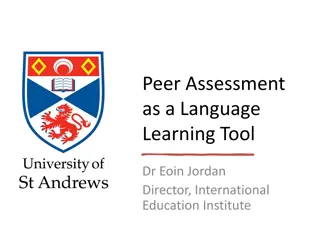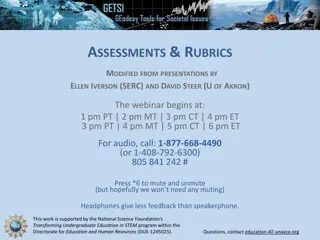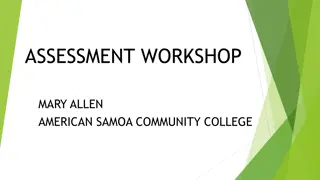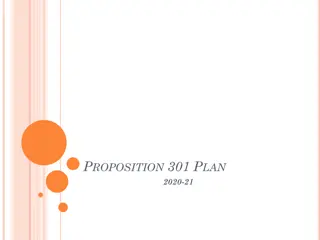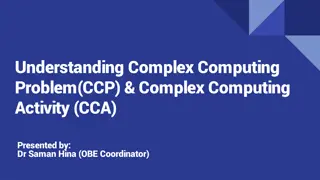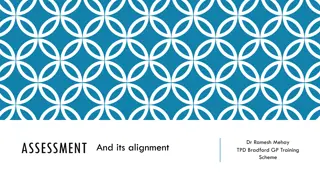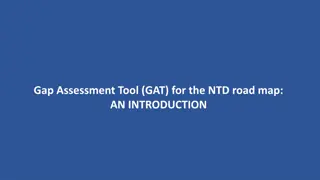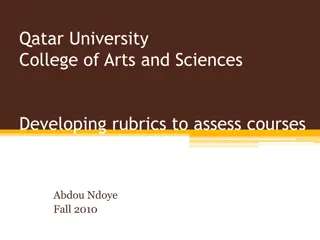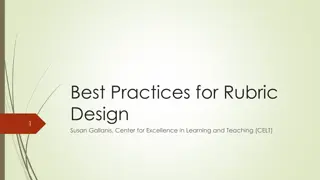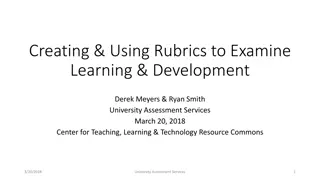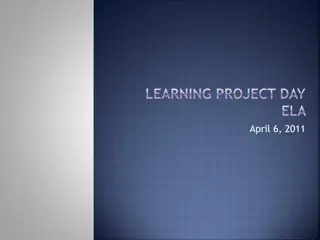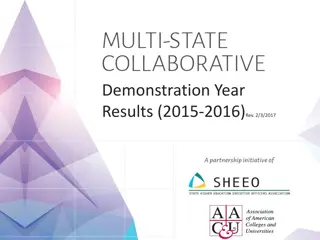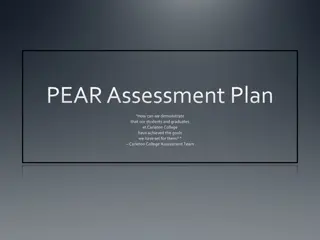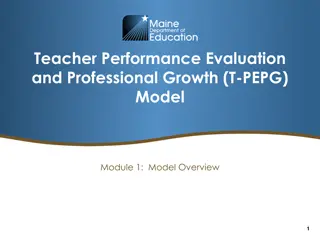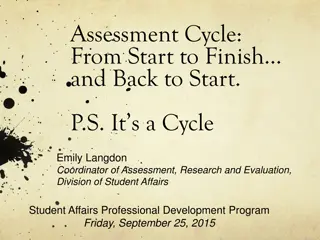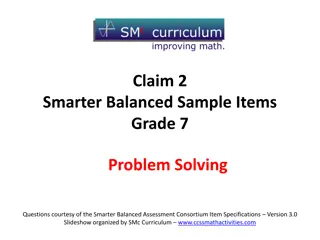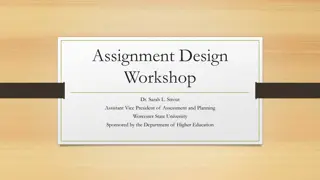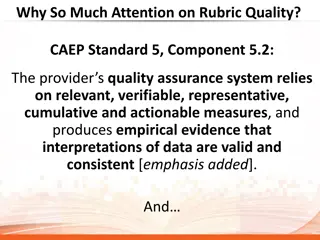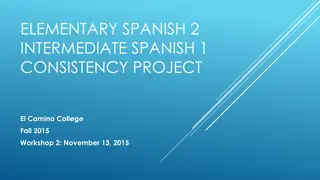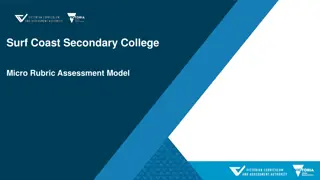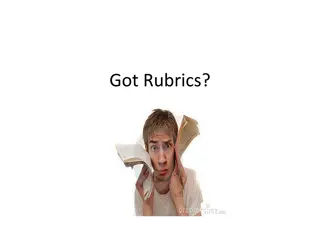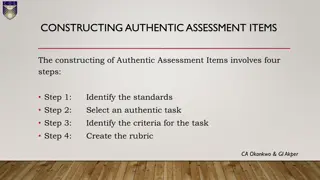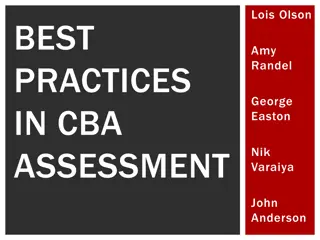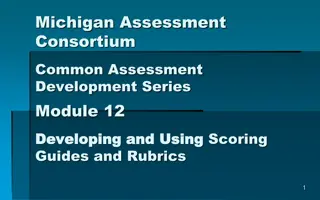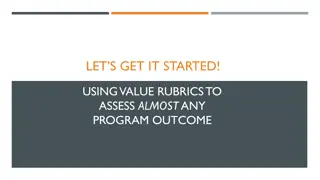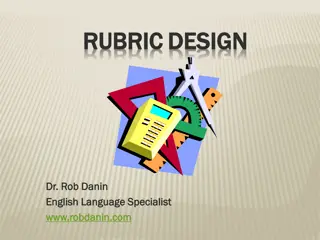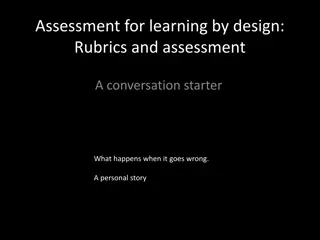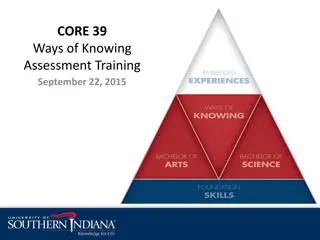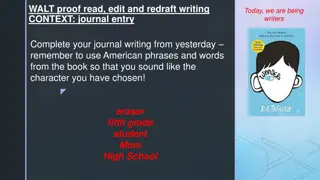Review of Grading Practices in PWCS and BRMS
This document outlines the assessment and grading practices in Prince William County Schools (PWCS) and Bull Run Middle School (BRMS) with a focus on providing feedback, enhancing student learning, and aligning assessments with learning outcomes. It includes information on assessment purposes, forma
3 views • 12 slides
Sheffield Early Help Assessment Form Update and Integration with Extended Support Plan
Sheffield has introduced an updated Early Help Assessment form to streamline the assessment process within the Early Help System. This new form combines the Early Help Assessment with the Extended Support Plan, aligning various assessment tools and referral forms into one comprehensive document. The
5 views • 22 slides
Enhancing Language Learning Through Peer Assessment
Explore the benefits of peer assessment as a valuable tool for language learning, comparing it with self-assessment. Discover the components and challenges of self-assessment, along with the potential of peer assessment to improve accuracy and promote self-regulation. Gain insights into what peer as
3 views • 29 slides
ASSESSMENTS & RUBRICS
Enhance your understanding of assessments and rubrics in STEM education through a comprehensive webinar covering terminology, proposal strategies, and practical usage of materials design rubrics. Delve into setting learning goals, aligning outcomes, and designing instructional strategies for success
1 views • 25 slides
Overview of DSW End Point Assessment Team Leader Level 3
DSW End Point Assessment Team Leader Level 3 provides a clear understanding of the assessment process, ensuring individuals comprehend why and when it occurs, responsibilities involved, and how DSW supports them. It covers topics such as what End Point Assessment entails, assessment design and deliv
1 views • 18 slides
Assessment Workshop at American Samoa Community College
Explore the process of assessment, including topics like rubrics, reliability, validity, data analysis, direct vs. indirect assessments, and examples of learning outcomes. Discover the strengths and methods of creating rubrics to evaluate student work effectively.
0 views • 74 slides
Proposition 301 Plan Overview for Teacher Compensation
The Proposition 301 Plan for the 2020-21 academic year outlines a structured approach to pay increases for teachers. It includes three components: a 20% increase to base salary, 40% for meeting performance goals, and 40% for duties fulfilled from a set list of menu items. The plan also details speci
0 views • 19 slides
Understanding Complex Computing Problem (CCP) and Complex Computing Activity (CCA)
Dr. Saman Hina, along with Dr. Farrukh Arif and Dr. Maria Waqas, presents information on Complex Computing Problem (CCP) - a problem involving technical, computing, and other issues with no obvious solution, requiring deep knowledge and analytical thinking. CCP is evaluated through predefined rubric
4 views • 19 slides
Understanding Assessment in Medical Education
Exploring the concepts of assessment in medical education, including defining assessment, types of assessment, reliability, validity, and aligning assessment methods with intended learning outcomes. The importance of constructive alignment and the impact of assessment on learning outcomes are also d
1 views • 12 slides
Advancing NTD Roadmap through the 2022 Gap Assessment Tool (GAT) Introduction
Introducing the Gap Assessment Tool (GAT) for the NTD roadmap, focusing on disease-specific assessments like Schistosomiasis. The 2022 GAT aims for greater standardization and objectivity in assessment criteria across diseases with specific rubrics defined for each dimension.
0 views • 18 slides
Rubrics and Authentic Assessments in Course Evaluation at Qatar University
Workshop focused on developing rubrics for assessing courses at Qatar University College of Arts and Sciences. It covers the rationale for using rubrics, different assessment types, challenges of authentic assessment, and the role of rubrics in ensuring consistency and reliability in evaluating stud
0 views • 14 slides
Best Practices for Rubric Design in Teaching
Explore the key components of rubrics, understand their importance in assessment, and learn how to effectively design and use them to enhance student learning outcomes.
0 views • 18 slides
Understanding and Utilizing Rubrics for Assessment
A rubric is a scoring tool that outlines specific expectations for evaluating assignments or projects. This tool helps in identifying key criteria for assessment and provides a structured approach to grading. Rubrics play a vital role in enhancing learning outcomes and promoting consistency in evalu
0 views • 26 slides
Enhancing Feedback Strategies in ELA Learning Project Day
Refine understanding of ELA, engage with student exemplars, and design constructive feedback in a structured agenda. Activities include generating feedback, digging deeper into feedback processes, and considering the impact of timely and specific feedback on student growth in learning and skills. Co
0 views • 31 slides
Multi-State Collaborative for Advancing Quality Student Learning
Slides showcasing results from the demonstration year (2015-2016) of the Multi-State Collaborative for Advancing Quality Student Learning involving 12 states. Study findings reflect the use of common rubrics to assess student work and highlight the challenges and benefits of the VALUE rubrics. Facul
2 views • 32 slides
Carleton College Assessment Plan for P.E.A.R. Programs
Carleton College aims to assess the achievement of student learning goals in its P.E.A.R. programs through identifying learning outcomes, developing assessment measures, collecting evidence, and reviewing results using tools like surveys and rubrics. The focus is on skill acquisition, knowledge enha
0 views • 13 slides
Teacher Performance Evaluation and Professional Growth (T-PEPG) Model Overview
This training module provides an in-depth look at the Teacher Performance Evaluation and Professional Growth (T-PEPG) model, focusing on key features, structure, and terminology of the MSFE rubric. Participants will explore self-assessment, reflection, goal-setting, student learning objectives, evid
0 views • 40 slides
Comprehensive Guide to Kindergarten Writing Training for NYSESLAT 2019
Explore a detailed guide on Kindergarten Writing Training for the NYSESLAT 2019 exam. The training covers four constructed-response types including Letter Writing, Word Writing, Sentence Writing, and Writing a Story. Gain insights into the application of holistic writing rubrics, analyzing student r
0 views • 24 slides
Understanding Higher Education Assessment: The Complete Guide
Higher education assessment involves a systematic process of collecting, reviewing, and utilizing information to improve student learning and development. This guide covers the assessment cycle, learning outcomes, the mission behind assessment in higher education, what assessment is and is not, reas
1 views • 36 slides
Strategic Learning Outcomes and Assessment Plan at SCSU
Strategic overview of St. Cloud State University's commitment to institutional learning outcomes, assessment plan implementation, governance structure, oversight committee, and tools used for evaluation such as rubrics and surveys. Emphasis on student graduation goals and educational values.
0 views • 28 slides
Grade 7 Smarter Balanced Sample Problem-Solving Questions
Get ready to solve challenging Grade 7 math problems with these sample questions from the Smarter Balanced Assessment Consortium. Test your problem-solving skills with questions on bank account balances, gas mileage, marching band members, and more. Check your answers against the provided answer rub
0 views • 35 slides
Overview of Environmental Impact Assessment and Strategic Environmental Assessment Directives
Environmental Impact Assessment (EIA) and Strategic Environmental Assessment (SEA) play crucial roles in evaluating the impact of planned activities on the environment. This content delves into the concept, origins, development, and key elements of environmental assessment, discussing the legal fram
2 views • 35 slides
Institutional Assessment and Effectiveness Workshop Achievements at SUNY Oneonta
The Office of Institutional Assessment and Effectiveness at SUNY Oneonta has made significant progress in developing assessment protocols and processes, leading to a culture of assessment. This includes completing planning and assessment cycles, establishing objectives and procedures, and aligning u
1 views • 16 slides
Enhancing Student Success Through Inclusive Assignment Design
Effective assignment design is crucial for student success, particularly for first-generation and underrepresented students. Clear instructions, transparent rubrics, and inclusive assessment approaches are key factors in promoting learning outcomes and reducing biases. Inclusive assignments should a
0 views • 15 slides
Enhancing Rubric Quality in Educational Assessment
The focus on rubric quality in education, particularly in meeting CAEP Standard 5, Component 5.2 for quality assurance systems, is crucial for generating valid, reliable, and actionable data. CAEP now allows early submission of assessment instruments to improve data quality. However, common weakness
0 views • 22 slides
Understanding Constructed Response Items in Education
Exploring the concept of constructed response items in education, this content delves into the complexities of student responses, assessment for learning, rubric development, and differentiation strategies. Richard Woods, Georgia's School Superintendent, provides insights on how to navigate through
0 views • 31 slides
An Overview of P@N: Portfolio@Naz Chalk & Wire for Student Assessment
Explore the functionalities of P@N, an electronic portfolio tool for students to archive, track their learning, and demonstrate knowledge. It provides a common interface for faculty/staff to assess student work against program SLOs, core rubrics, and criteria, aiding in program improvement and asses
0 views • 28 slides
Workshop on Establishing Proficiency Levels and Assessment Criteria in Spanish Education
Workshop held at El Camino College in Fall 2015 focused on addressing issues in Spanish education such as textbook vouchers and grading criteria for Spanish 2 & 3 SLO. The event emphasized the difference between proficiency and performance and showcased rubrics for assessing student learning through
0 views • 14 slides
Understanding Micro Rubrics in Educational Assessment
A micro rubric is a detailed assessment tool used at the end of learning activities to evaluate student performance and guide self-reflection. It consists of levels ranging from "Not Submitted" to "Excelling" and helps students improve their work through targeted feedback. Micro rubrics differ from
0 views • 6 slides
Mastering Rubrics: Types, Design, and Application
Understand the essentials of rubrics by exploring various types like checklists, rating scales, Likert-type scales, holistic, and analytic rubrics. Learn about the characteristics of good rubrics and how to create effective scoring guides. Get insights from examples like the University of Pittsburgh
0 views • 9 slides
Constructing Authentic Assessment Items: A Guide in 4 Steps
Constructing authentic assessment items involves four steps: identifying standards, selecting an authentic task, defining criteria, and creating a rubric. Standards are specific skills and knowledge students should gain. Tasks should reflect these standards. Criteria measure student mastery. Rubrics
0 views • 25 slides
Enhancing Student Success in UC Merced Biological Sciences Program
Curriculum strategies and assessment outcomes are discussed for the Biological Sciences Major at UC Merced. The program aims to improve student proficiency in various learning outcomes through faculty-created rubrics and direct/indirect evidence assessment methods. Results show strengths and areas f
0 views • 19 slides
Best Practices in CBA Assessment and Evaluating Students in Group Projects
This content discusses best practices in Cost-Benefit Analysis (CBA) assessment along with strategies for evaluating individual students in a group project class. It covers topics such as analyzing IMC strategies, developing IMC plans, assessing communication effectiveness, and using evaluation rubr
0 views • 24 slides
Developing and Using Scoring Guides and Rubrics in Assessment
Explore the importance of rubrics and scoring guides in assessment development, understanding different types of rubrics, developing and using them effectively, and addressing bias through objective criteria. Learn how rubrics help in evaluating student responses and providing feedback for improveme
0 views • 52 slides
Understanding Value Rubrics for Comprehensive Program Assessment
Explore the use of VALUE rubrics for assessing program outcomes, creating aligned assignments, collecting student work effectively, and improving student skills. Learn about AAC&U's 15 VALUE rubrics and their applications in course and program evaluation. Discover how to define performance level
0 views • 24 slides
Mastering Rubric Design for Effective Assessment
Rubrics are essential tools in evaluating and providing feedback on student performance. This comprehensive guide covers the definition, elements, and benefits of rubrics, along with expert tips on designing impactful rubrics for various assessments. Explore the art of rubric design, learn what make
0 views • 30 slides
Enhancing Assessment Practices Through Rubrics and Conversational Learning
Explore the critical aspects of rubrics in assessment design, including the distinction between holistic and analytical rubrics, their respective applications, and how they can be leveraged as learning tools. Discover the importance of aligning rubrics with course objectives and engaging students in
0 views • 10 slides
Streamlining the CORE 39 Assessment Process: A Closer Look at Rubrics and Deadlines
A detailed insight into the CORE 39 assessment process, focusing on the creation of rubrics aligned with key assignments. Learn about the formation of the CORE 39 Assessment Task Force and the use of Tk20 software for assessment. Important deadlines and the role of rubrics in grading are highlighted
0 views • 23 slides
Enhancing Assessment Practices through Effective Rubrics Design
Explore the importance of well-designed rubrics in assessment practices, focusing on avoiding pitfalls and maximizing student understanding. Learn how to create powerful rubrics that guide students towards essential learning outcomes. Gain insights on improving assessment strategies and fostering cl
0 views • 17 slides
Writing Workshop: Refining Your Journal Entries with American Phrases
Embrace being a writer by incorporating American phrases and character-specific language from the book in your journal entries. Learn the nuances between proofreading and editing, utilize rubrics for self-assessment, and enhance your writing skills through vocabulary exploration and comprehension st
0 views • 7 slides


